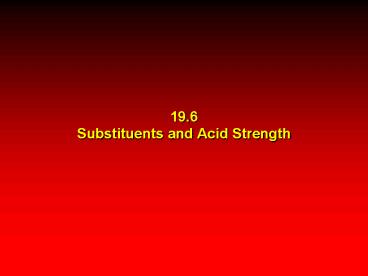19'6 Substituents and Acid Strength - PowerPoint PPT Presentation
1 / 25
Title:
19'6 Substituents and Acid Strength
Description:
19.6. Substituents and Acid Strength. standard of comparison is acetic acid (X = H) ... sp2-hybridized carbon is more electron-withdrawing than sp3, and sp is more ... – PowerPoint PPT presentation
Number of Views:19
Avg rating:3.0/5.0
Title: 19'6 Substituents and Acid Strength
1
19.6Substituents and Acid Strength
2
Substituent Effects on Acidity
standard of comparison is acetic acid (X H)
pKa 4.7
3
Substituent Effects on Acidity
4
Substituent Effects on Acidity
- electronegative substituents withdraw electrons
from carboxyl group increase K for loss of H
5
Effect of electronegative substituent
decreasesas number of bonds between it and
carboxyl group increases.
pKa
ClCH2CH2CH2CO2H
6
19.7Ionization ofSubstituted Benzoic Acids
7
Hybridization Effect
- sp2-hybridized carbon is more electron-withdrawin
g than sp3, and sp is more electron-withdrawing
than sp2
8
Table 19.3 Ionization of Substituted Benzoic
Acids
- effect is small unless X is electronegative
effect is largest for ortho substituent
pKa Substituent ortho meta para H 4.2 4.2 4.2 CH
3 3.9 4.3 4.4 F 3.3 3.9 4.1 Cl 2.9 3.8 4.0 CH3O 4.
1 4.1 4.5 NO2 2.2 3.5 3.4
9
19.8Dicarboxylic Acids
10
Dicarboxylic Acids
pKa
Oxalic acid
Malonic acid
Heptanedioic acid
- one carboxyl group acts as an electron-withdrawin
g group toward the other effect decreases with
increasing separation
11
19.9Carbonic Acid
12
Carbonic Acid
H2O
CO2
99.7
0.3
- CO2 is major species present in a solution of
"carbonic acid" in acidic media
13
Carbonic Acid
Ka 5.6 x 10-11
Second ionization constant
H
14
19.10Sources of Carboxylic Acids
15
Synthesis of Carboxylic Acids Review
- side-chain oxidation of alkylbenzenes (Section
11.13) - oxidation of primary alcohols (Section 15.10)
- oxidation of aldehydes (Section 17.15)
16
19.11Synthesis of Carboxylic Acidsby
theCarboxylation of Grignard Reagents
17
Carboxylation of Grignard Reagents
Mg
CO2
RMgX
RX
diethylether
H3O
- converts an alkyl (or aryl) halide to a
carboxylic acid having one more carbon atom than
the starting halide
18
Carboxylation of Grignard Reagents
?
C
O
19
Example Alkyl Halide
1. Mg, diethyl ether
2. CO2 3. H3O
Cl
CO2H
(76-86)
20
Example Aryl Halide
1. Mg, diethyl ether
2. CO2 3. H3O
(82)
21
19.12Synthesis of Carboxylic Acidsby
thePreparation and Hydrolysis of Nitriles
22
Preparation and Hydrolysis of Nitriles
H3O
RX
heat
SN2
NH4
- converts an alkyl halide to a carboxylic acid
having one more carbon atom than the starting
halide - limitation is that the halide must be reactive
toward substitution by SN2 mechanism
23
Example
NaCN
DMSO
(92)
24
Example Dicarboxylic Acid
BrCH2CH2CH2Br
NaCN
H2O
(77-86)
NCCH2CH2CH2CN
25
via Cyanohydrin
1. NaCN
2. H































